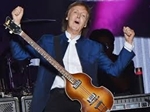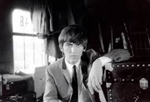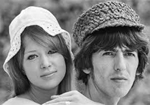- Register
- Log in to Tune-In
- Wishlist (0)
-
Shopping cart
(0)
You have no items in your shopping cart.
Beatles News

When The Beatles broke up, John Lennon, Paul McCartney, and Ringo Starr all seemed a bit adrift for their first few years as ex-members of The Fab Four. Only George Harrison seemed to be thriving on his own, at least in terms of his career choices.
Maybe that’s because Harrison no longer had to answer to his bandmates when it came down to the material he wanted to present. If he wanted to go the spiritual route, as he did on the 1970 track “Hear Me Lord”, there was no one to stop him. The final year or so of The Beatles as a group was a particularly unhappy time for the four members in terms of their interactions. In one notorious example, George Harrison clashed with Paul McCartney while cameras were rolling in January 1969 on a documentary about the group’s new record.
Earlier that fateful day, Harrison had tried to interest the other members in a new track of his called “Hear Me Lord”. Unfortunately, like so many other Harrison compositions of that era, The Beatles couldn’t be bothered to do much with it. Harrison added it to his stockpile of unrecorded songs. He would unleash that stockpile upon the world as part of the triple album All Things Must Pass in 1970. details

Beatles history is full of stories about Paul McCartney’s dual life as a bassist and guitarist. After getting saddled with the instrument when Stuart Sutcliffe left the group in July 1961, McCartney didn’t play guitar with the Beatles again until 1965’s Help! album. In addition to performing acoustic guitar on the album cut “Yesterday,” he took electric guitar solos on the songs “Another Girl,” “The Night Before” and “Ticket to Ride.” It was quite a shift for McCartney, considering he’d originally been put off playing lead guitar after his first attempt to do so onstage became a disaster.
In fact, it was that very episode of stage fright that resulted in George Harrison joining the group, at McCartney’s suggestion, seeing as neither he nor John Lennon had any facility for playing lead. Paul’s inability is ultimately what got him stuck playing bass, as Lennon had no ability to play the instrument and Harrison was too vital as a lead guitarist.
Of course, once McCartney began to solo, it was hard to stop him. He took solo sports on Harrison’s Revolver cut “Taxman,” when Harrison was unable to come up with anything details

Every so often, Paul McCartney and John Lennon would conjure up a Beatles song specifically for Ringo Starr to sing. And as one would expect from songs written for the least singing member of the band, some were better than others (both in chart performance and the general opinion of the rest of the band).
One of the first songs Lennon wrote for Starr was left on the cutting room floor, although the musicians would mention the song in later interviews. To Lennon, it was hilarious. To George Harrison, the throwaway song was just plain weird.
John Lennon Wrote This Beatles Song For Ringo Starr
Although the Beatles originally intended for Ringo Starr to sing John Lennon’s song, “If You’ve Got Trouble,” on the 1965 album Help!, the band decided to scrap the song. From the lyrics to the melody to Starr’s humble performance, the Beatles ultimately left the song in the EMI Studios vault. During a 1965 interview with Melody Maker, Lennon described the song as hilarious.
“It’s the funniest thing I’ve ever done,” Lennon laughed. “I didn’t expect anybody to want to record it.” Guitarist George Harrison had an even blunter take. “It&r details

“‘There’s a Place’ was my attempt at a sort of Motown, black thing.
It says the usual Lennon things: ‘In my mind there’s no sorrow…’ It’s all in your mind.”
“There’s A Place” – the very first song recorded during the 11 February 1963 Please Please Me EMI session – was exceptional for its day (and for ours). As Wilfrid Mellers later pointed out in Twilight of the Gods, it was the first Beatles song about self-reliance. It established songwriter John Lennon’s recurring theme of “finding comfort in his thoughts, dreams, and memories…[dealing] with life’s sorrow by retreating into the safety of his inner thoughts…”, a significant theme Lennon would repeat in “later songs such as ‘Strawberry Fields Forever,’ ‘Girl,’ ‘In My Life,’ ‘Rain,’ ‘I’m Only Sleeping,’ ‘Tomorrow Never Knows’.” No “moon, June, croon, spoon” song, “There’s a Place” introduces a more sophisticated scenario.
McCartney supplied the inspiration for this song: the Leonard Bernstein/Stephen Sondheim details

It felt like any other summer day in Liverpool, but a chance encounter turned into one of the most notable days in music history: the day John Lennon first met Paul McCartney. On July 6, 1957, St. Peter’s Church in Woolton Village was having a church party, where The Quarrymen — Lennon’s skiffle band at the time — played.
“Apparently, we were on stage playing the Del-Vikings doo-wop number 'Come Go With Me,’ and Paul arrived on his bicycle and saw us playing,” Rod Davis of The Quarrymen recalled to Billboard. “It was somebody we didn’t know, Paul, who met someone we did know. It wasn’t a big deal. You explain this to people, particularly Americans, and they expect there to be angels hiding behind clouds blowing trumpets. It’s all terribly, terribly a non-event — except in hindsight.”
During the meeting, mutual friend Ivan Vaughan introduced the two — and McCartney joined the band a few months later. While they eventually changed the direction of their sound to rock ‘n’ roll — and their name to The Beatles — what made their eventually success so sweet was the tight friendship between Lennon and McCartney, t details

Creator Phil Rosenthal remembered star Peter Boyle, who died in 2006. Rosenthal told the audience a little-known fact that John Lennon was the best man at Boyle’s wedding to his wife, Loraine Alterman, a journalist
Everybody Loves Raymond probably doesn’t make you think of The Beatles, but it just might now.
On Monday, June 16, at the Paley Center in New York City, Everybody Loves Raymond stars Ray Romano, Patricia Heaton and Maggie Wheeler, creator Phil Rosenthal and producer Tom Caltabiano reunited to celebrate 30 years of the hit sitcom. The comedy series, which also starred Brad Garrett and the late Peter Boyle and Doris Roberts, ran from 1996 to 2005 and continues to find new fans in syndication. Romano, 67, starred as sportswriter Ray Barone, and the characters around him were loosely based on his real family.
During the panel, the group took time to remember Boyle, who died in 2006 at 71. Boyle played Ray’s dad, Frank, who could be extremely stubborn and over-the-top with his sons. Coexecutive producer and writer Cindy Chupack remembered how she based a plotline for Frank on her own dad, who was a “terrible driver,” and she said Boyle was “so belligerent&rd details

Even casual fans are familiar with the Beatles' album-opening songs.
Three of them went to No. 1, either in the U.K. or America, including 1964's "A Hard Day's Night," 1965's "Help!" and 1969's "Come Together." "I Saw Her Standing There" hit No. 1 in three other countries in 1963.
Tracks that were never issued as singles – 1965's "Drive My Car," 1966's "Taxman," 1967's "Sgt. Pepper's Lonely Hearts Club Band/With a Little Help From My Friends" and "Magical Mystery Tour," and 1968's "Back in the U.S.S.R." – have also become broadly familiar through radio and soundtrack spins.
Yet some lesser-known items still appear on the following list of Beatles Opening Songs Ranked From Worst to Best. "No Reply" quickly disappeared as a single in 1964, for instance, but has continued to grow in critical estimation. "Two of Us," from 1970's Let It Be, remains one of their late era's most congenial gems.
Which one's best? Here's a ranked look back at the songs that began every album by the Beatles:
No. 12. "It Won't Be Long"
From: With the Beatles (1963)
"Please Please Me" rose to No. 2 in the U.K. and then "She Loves You" topped the charts. So they stuck with the formula: Pairing details

After seven decades of writing iconic songs and performing for millions around the globe, fans rallied around McCartney on his special day.
Paul McCartney celebrates his 83rd birthday on June 18, and after more than seven decades of writing iconic songs and performing for millions across the globe, he's showing no signs of slowing down. But as the music legend marks another milestone, fans are rallying around one shared fear. With heartfelt messages pouring in, one thing is clear: the world isn't ready to say goodbye to Sir Paul just yet.
Fans of The Beatles legend took to Reddit to share their best birthday wishes. Most shared their hopes that the musician wouldn't consider retiring anytime soon.
One fan wrote, "I hope that I'll still be able to do three-hour concerts when I'm in my eighties." A second penned, "Long live Sir Paul McCartney!"
"Please don't ever retire, the world needs you. Happy birthday to you," a third fan exclaimed." A fourth admirer added, "Happy Birthday, Paul. Hope you have a wonderful day. May you be blessed with many more healthy and happy years. Keep making music, love you."
Source: Lucille Barilla/parade.com

A dollar bill signed by George Harrison is currently up for auction. It's listed among many items connected to classic rock artists.
Over two decades after his death, George Harrison is still proving how much his name is worth to Beatles fans. Harrison, who found the sale of Beatles memorabilia to be a bit strange, signed a dollar bill for a fan years ago. That item is currently up for auction and will bring in hundreds more than what the bill alone is worth. A dollar bill signed by George Harrison is up for auction.
RR Auction is currently auctioning off items from prominent classic rock artists in their Marvels of Modern Music collection. The collection includes a number of items relating to The Beatles, Bob Dylan, Jimi Hendrix, and more.
One item up for auction is a dollar bill. Writing in black ballpoint pen reads “To Bob, George Harrison.” Though it is unclear when Harrison signed the bill, it is from the 1981 series.
At the time of publication, the signed bill is worth over $600. Fans have until June 19 to purchase this item and more from the collection.
George Harrison was more concerned about the money in his pocket than his bandmates were. While Harrison said he di
details

Born on June 18, 1942, Paul McCartney grew up in Liverpool, England, and ... well you probably know the rest. He hit global fame at a young age as the heartthrob of The Beatles, and has since released album after album of hits while touring and raising a family.
Look back at his epic life in photos as the legendary musician turns 83 on June 18, 2025.
McCartney was raised in Liverpool, England, with his parents and younger brother Peter Michael. His dad was a self-taught musician, and often gathered the family around the piano at night for a musical wind-down.
"I have some lovely childhood memories of lying on the floor and listening to my dad play 'Lullaby of the Leaves' [and other] old songs like [George Gershwin's] 'Stairway to Paradise,' " Paul said in interviews published in The Beatles Anthology.
Paul was a solid student and sang in the church choir while balancing piano and trumpet lessons.
Paul successfully campaigned his dad for a guitar and learned to play Elvis Presley, Buddy Holly and Everly Brothers hits by ear.
At the Liverpool Institute, Paul reconnected with an old school friend, George Harrison, and soon after, met John Lennon.
"You saw him rather than met details

Beyoncé concluded the final night of her Cowboy Carter tour‘s six-show run at Tottenham Hotspur Stadium in London on Monday, and took to social media to celebrate the moment, while also showing love for one of England’s most influential musicians of all time.
“Thank you, Sir Paul McCartney, for writing one of the best songs ever made,” wrote Beyoncé in an Instagram post. “Every time I sing it I feel so honored.” Beyoncé’s rendition of the Beatles’ White Album classic “Blackbird” was included on her historic, Grammy-winning Cowboy Carter album released last year.
In her post, the singer also included photos of her performing in fringe chaps and a white tee adorned with two blackbirds, crediting McCartney’s daughter, fashion designer Stella McCartney: “it is a full circle moment to wear your beautiful daughter’s design.”
“Thank you, London, for creating unforgettable memories for me and my family,” she wrote, before hinting at her return: “Holla at ‘ya when I come on tour again!”
McCartney previously applauded Beyoncé’s cover of“Blackbird,” details

The Beatles legend was apparently not pleased that the group sacked his son not once, but twice.
Zak Starkey isn’t the only one who has had enough of The Who. In a new Rolling Stone interview posted on Monday (June 16) the veteran session and touring drummer who was fired, rehired and then fired once more by The Who in a head-spinning span of several weeks earlier this year opened up about his current relationship with the band and how his dad feels about the tabloid tussle.
Asked what his father, former Beatles drummer Ringo Starr, thought of the bizarre back-and-forth, Starkey said, “He [Ringo] said, ‘I’ve never liked the way that little man runs that band,'” in seeming reference to The Who singer Roger Daltrey.
After The Who “made a collective decision” to part ways with Starkey in April after his nearly 30 years behind the kit, guitarist/songwriter Pete Townshend relented a few days later and rescinded the firing, saying Starkey was “not being asked” to step down from his position. Then, a month later, Townshend took it all back and said after many years working together “the time has come for a change.” A week later, Starkey cla details

Pattie Boyd is one of the very few people in the world who can say she’s been married to not one but two rock icons. The model and photographer, who was famously married to George Harrison, only to leave him for Eric Clapton after a decade, was one of the ultimate musical muses.
Boyd’s name is synonymous with the swinging ’60s, and the many songs she inspired are classics of the era. Now 81, Boyd is still going strong, and her photography exhibitions featuring indelible images of her musical peers have earned acclaim for her keen eye. In 2007, she published a bestselling memoir, Wonderful Tonight: George Harrison, Eric Clapton, and Me, and flipped the narrative on the muse label by finally sharing her side of the story.
Pattie Boyd was in high demand as a model, rocking looks from Swinging London designers like Ossie Clark and Mary Quant, and a 1964 potato chip commercial she starred in ended up being pivotal in her personal life. The ad was directed by Richard Lester, who’d go on to direct the Beatles movies A Hard Day’s Night and Help!, and he was so charmed by Boyd that he offered her a bit part in the Fab Four’s first film.
Source: womansworld.com/Abbey Bender details

Paul McCartney makes sweet nod to late wife Linda as he marks Father's Day with throwback snap. The Beatles star Sir Paul McCartney has shared a touching family memory to mark Father's Day. Paul, who is father to five children, celebrated Father's Day (Sunday June 15) with a sweet throwback picture on his Instagram of himself with his daughter Mary as a baby, being cradled in his jacket that was taken by his first wife Linda. In the caption he wrote: "All you wonderful fathers out there, have a great Father’s Day today! - Paul."
Fans have flooded the comments to praise the sweet father and daughter moment from The Beatles star, as one wrote: "My absolute favourite picture of Paul and sweet Mary."
Paul, who turns 83 tomorrow, is a father to five kids including three biological and one adopted with late wife Linda McCartney.
The singer-songwriter, who turns 83 on June 18, first became a father in 1969, when he married photographer Linda Eastman and adopted her daughter from a previous marriage, Heather, 62. The couple eventually went on to welcome three kids: Mary, 55, Stella, 53, and James, 47.
Source: themirror.com/Niamh Spence

George Harrison was an English musician best known as the lead guitarist of The Beatles, one of the most famous bands in history. Often called the quiet Beatle, he brought Indian music and spiritual ideas into the group’s songs.
He wrote classics like Here Comes the Sun and Something for The Beatles. After the band split, he had a successful solo career with hits such as My Sweet Lord and organized the famous Concert for Bangladesh.
About the Song
Give Me Love (Give Me Peace on Earth) is a heartfelt plea wrapped in warm melodies and gentle guitar. The lyrics ask for light, life, and peace, aiming to lift worry and bring calm. The song’s music supports this honest message with smooth rhythm and memorable tunes.
Detail Information
Release Date May 7, 1973
Album Let It Roll: Songs by George Harrison (2009)
Writer George Harrison
Producer George Harrison
Give Me Love (Give Me Peace on Earth) Lyrics
Give me love, give me love
Give me peace on earth
Give me light, give me life
Keep me free from birth
Give me hope, help me cope
With this heavy load
Trying to touch and reach you with
Heart and soul
Om, my Lor
details
